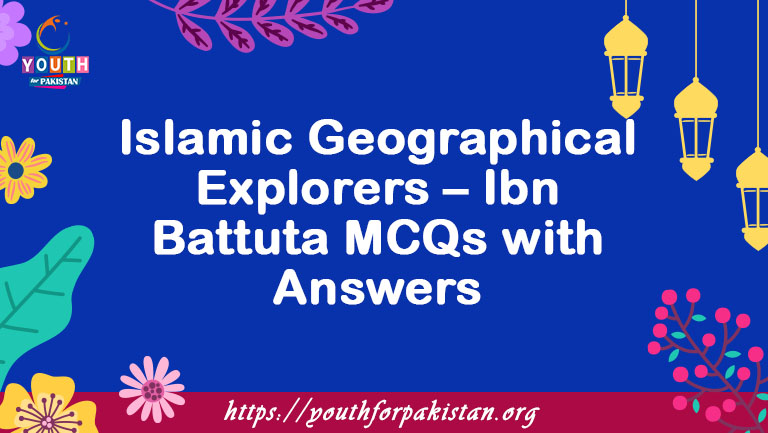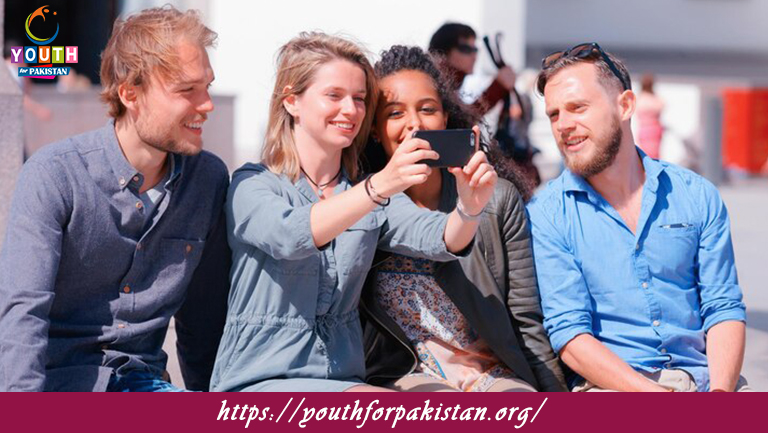The following are Islamic Geographical Explorers – Ibn Battuta MCQs with answers related to Islamic Studies. We have arranged the most important and repeated MCQs in all the competitive examinations. The students can clear their concepts for Islamic Geographical Explorers – Ibn Battuta MCQs online quiz by attempting these.
Islamic Geographical Explorers – Ibn Battuta Online MCQs with Answers
Ibn Battuta, the famous Muslim explorer, was born in which city?
A) Cairo
B) Mecca
C) Tangier
D) Istanbul
Ibn Battuta is best known for his extensive travels during the:
A) 7th century
B) 10th century
C) 14th century
D) 16th century
Ibn Battuta’s journey covered approximately how many kilometers, making him one of history’s most prolific travelers?
A) 5,000 km
B) 15,000 km
C) 30,000 km
D) 50,000 km
Ibn Battuta embarked on his travels primarily for which purpose?
A) Trade
B) Religious pilgrimage
C) Scientific research
D) Military conquest
Ibn Battuta’s initial journey took him to the holy city of:
A) Mecca
B) Medina
C) Jerusalem
D) Cairo
How many years did Ibn Battuta spend on his travels, visiting numerous countries and regions?
A) 5 years
B) 12 years
C) 24 years
D) 30 years
During his travels, Ibn Battuta served as a:
A) Diplomat
B) Merchant
C) Soldier
D) All of the above
Ibn Battuta’s travelogue, “Rihla,” provides valuable insights into the:
A) Astronomy of the Islamic world
B) Literature of the medieval era
C) Geography and cultures of the regions he visited
D) Architectural achievements of the Islamic Golden Age
What Islamic school of thought did Ibn Battuta adhere to?
A) Sunni
B) Shia
C) Sufi
D) Ibadi
Ibn Battuta’s journey began with a pilgrimage to Mecca, which is one of the Five Pillars of Islam. What is the Arabic term for this pilgrimage?
A) Zakat
B) Salat
C) Hajj
D) Sawm
Which famous Islamic traveler and scholar inspired Ibn Battuta’s own travels?
A) Al-Khwarizmi
B) Al-Razi
C) Al-Farabi
D) Ibn Jubayr
During his journeys, Ibn Battuta visited various African regions, including:
A) Timbuktu
B) Zanzibar
C) Alexandria
D) All of the above
Which empire did Ibn Battuta serve as a judge (qadi) during his travels in India?
A) Mughal Empire
B) Ottoman Empire
C) Delhi Sultanate
D) Abbasid Caliphate
In which African city did Ibn Battuta encounter the famous traveler Ibn Jubayr, who inspired his own wanderlust?
A) Timbuktu
B) Cairo
C) Mecca
D) Zanzibar
Ibn Battuta’s travels took him through various Asian regions, including:
A) China
B) Japan
C) Australia
D) None of the above
During his time in China, Ibn Battuta served the emperor of the:
A) Tang Dynasty
B) Yuan Dynasty
C) Ming Dynasty
D) Qin Dynasty
Ibn Battuta’s extensive travels led him to explore regions as far as:
A) North America
B) South America
C) Europe
D) Antarctica
What was the primary language that Ibn Battuta used for his travelogue, “Rihla?
A) Arabic
B) Persian
C) Urdu
D) Latin
Ibn Battuta’s journey took him to various Indian states, including:
A) Rajasthan
B) Kerala
C) Punjab
D) All of the above
During his travels, Ibn Battuta often faced challenges such as:
A) Political conflicts
B) Language barriers
C) Hostile environments
D) All of the above
Ibn Battuta’s exploration of the Sahara Desert brought him to the legendary city of:
A) Cairo
B) Timbuktu
C) Baghdad
D) Mecca
During his travels in West Africa, Ibn Battuta encountered the powerful:
A) Ghana Empire
B) Songhai Empire
C) Mali Empire
D) Zulu Empire
In which Indian city did Ibn Battuta serve as a qadi (judge) and witness the construction of several magnificent structures?
A) Delhi
B) Mumbai
C) Jaipur
D) Kolkata
Ibn Battuta’s travelogue, “Rihla,” is considered one of the most important sources of information about the:
A) Silk Road
B) Mongol Empire
C) Indian Ocean trade
D) African savannah
During his travels in the Middle East, Ibn Battuta visited the holy city of:
A) Cairo
B) Jerusalem
C) Baghdad
D) Istanbul
Ibn Battuta’s extensive travels contributed to a better understanding of:
A) Ancient Greek philosophy
B) Medieval European history
C) Islamic geography and cultures
D) Chinese calligraphy
In which region did Ibn Battuta experience the harsh conditions of the Gobi Desert?
A) Arabia
B) Central Asia
C) North Africa
D) South America
Ibn Battuta’s travels took him to various Islamic empires and dynasties, including the:
A) Umayyad Caliphate
B) Rashidun Caliphate
C) Abbasid Caliphate
D) Ottoman Empire
In which part of the world did Ibn Battuta spend a significant amount of time studying Islamic law?
A) North America
B) South America
C) Central Asia
D) North Africa
Ibn Battuta’s travels encompassed regions as diverse as:
A) South America and Australia
B) Europe and Asia
C) North America and Antarctica
D) Africa and the Middle East
In which Indian state did Ibn Battuta serve as a qadi (judge) and interact with local rulers?
A) Gujarat
B) Rajasthan
C) Kerala
D) Punjab
Ibn Battuta’s travelogue, “Rihla,” provides valuable information about the political and cultural life of the:
A) Roman Empire
B) Ottoman Empire
C) Islamic world during his time
D) Indian subcontinent during the Gupta Dynasty
During his travels in China, Ibn Battuta visited the city of:
A) Xi’an
B) Tokyo
C) Mumbai
D) Moscow
Ibn Battuta’s journey to the Swahili Coast of East Africa allowed him to explore regions such as:
A) Madagascar
B) Somalia
C) Sri Lanka
D) All of the above
During his time in India, Ibn Battuta served as a:
A) Merchant
B) Scholar
C) Judge (qadi)
D) Warrior
In the Indian subcontinent, Ibn Battuta’s travels took him to the Sultanate of:
A) Bengal
B) Punjab
C) Kerala
D) Delhi
Ibn Battuta’s exploration of the Indian Ocean region allowed him to study the monsoon winds and their impact on:
A) Agriculture
B) Trade and navigation
C) Oceanography
D) Desertification
Which of the following was NOT a region Ibn Battuta explored during his travels?
A) Sahara Desert
B) Andes Mountains
C) Indian subcontinent
D) Arabian Peninsula
Ibn Battuta’s travelogue, “Rihla,” is written in the form of:
A) Poetry
B) Short stories
C) Letters to friends
D) An autobiography
During his travels, Ibn Battuta faced numerous dangers, including encounters with:
A) Mythical creatures
B) Pirates and bandits
C) Friendly tribes
D) Alien civilizations
Ibn Battuta’s exploration of the Swahili Coast allowed him to observe the blending of Islamic culture with:
A) European traditions
B) African traditions
C) Chinese traditions
D) Inca traditions
In which city did Ibn Battuta study Islamic law and jurisprudence under renowned scholars?
A) Baghdad
B) Cairo
C) Mecca
D) Timbuktu
Ibn Battuta’s travels in China allowed him to witness the grandeur of the:
A) Great Wall of China
B) Forbidden City
C) Terracotta Army
D) Hanging Gardens of Babylon
Ibn Battuta’s experiences as a judge (qadi) in India provided him with insights into the region’s:
A) Architecture
B) Cuisine
C) Legal system and society
D) Wildlife
Ibn Battuta’s travels allowed him to observe the customs and traditions of various cultures, contributing to his understanding of:
A) Cultural relativism
B) Cultural isolationism
C) Cultural imperialism
D) Cultural hegemony
In which Indian city did Ibn Battuta spend time studying and teaching Islamic law?
A) Delhi
B) Mumbai
C) Jaipur
D) Kolkata
Ibn Battuta’s detailed accounts of the regions he visited provided valuable information for:
A) Religious scholars
B) Cartographers and geographers
C) Astronomers
D) Botanists
Ibn Battuta’s travels through the Arabian Peninsula allowed him to witness the architectural wonders of:
A) Petra
B) Mecca
C) Dubai
D) Riyadh
Ibn Battuta’s exploration of the Indian Ocean trade network revealed the importance of maritime routes connecting:
A) Europe and Asia
B) North America and Africa
C) South America and Antarctica
D) Asia and Australia
In his travelogue, Ibn Battuta expressed his admiration for the cultural diversity and the shared values of the Islamic world, emphasizing the importance of:
A) Religious tolerance
B) Isolationism
C) Cultural uniformity
D) Linguistic diversity










